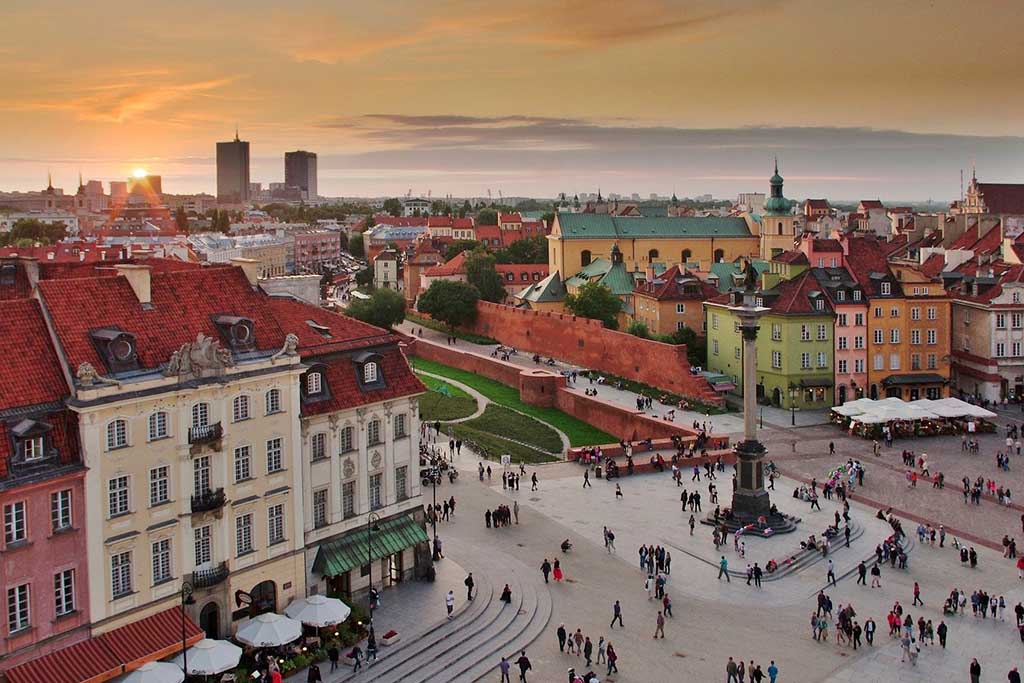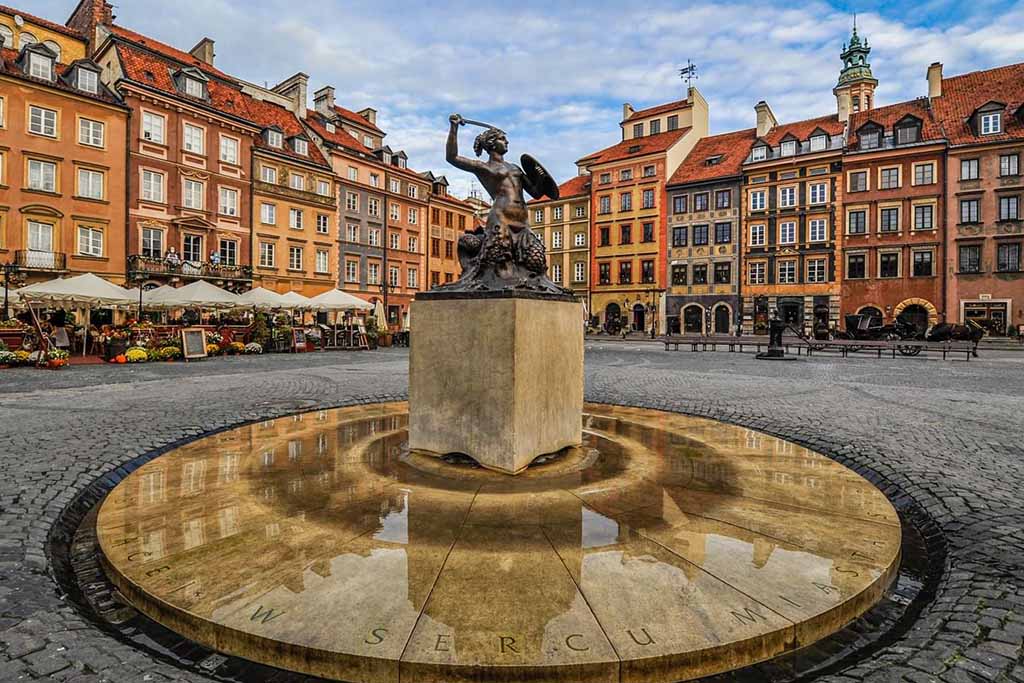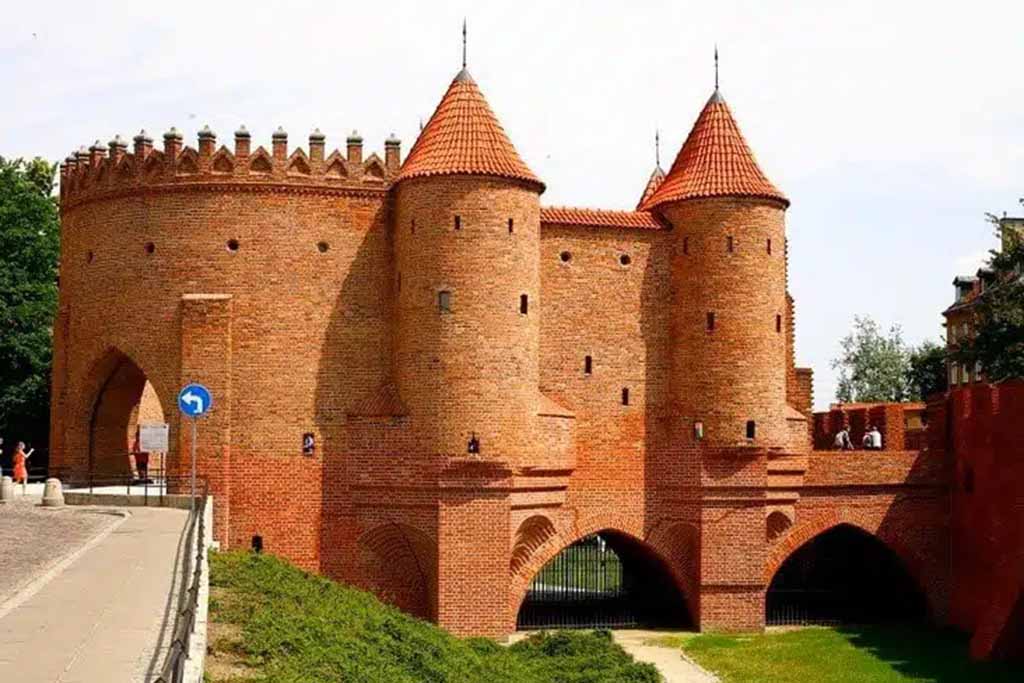As the political and cultural center of Poland, Warsaw is not only a transportation hub in Europe, but also a container of historical memory. The most soulful part of this city is the old town that was destroyed by war but miraculously rebuilt. It is the only UNESCO World Heritage site in the world that was almost completely rebuilt with historical drawings.
The Old Town of Warsaw was built in the late 13th century and is the heart of Polish history and culture. However, during World War II, more than 90% of the buildings here were destroyed. After the war, the Poles used paintings, photos and documents to restore it to its pre-war appearance with amazing perseverance. In 1980, the Old Town of Warsaw was listed as a World Cultural Heritage by the United Nations and became part of the collective memory of mankind.
Ⅰ. Recommended core attractions and travel guide
1. Warsaw Royal Castle (Zamek Królewski)
Location: Plac Zamkowy 4, 00-277 Warszawa
Opening hours: Tuesday to Sunday 10:00–18:00 (closed on Monday)
Suggested time: 1.5 hours

Transportation: Take the M1 subway line to Ratusz Arsenał station, and then walk for about 10 minutes
Booking platform: GetYourGuide, Klook
Cost: Adult ticket 40 Polish zloty (about RMB 70), student ticket 25 Polish zloty
As the former palace of the Polish king, the Royal Castle witnessed the rise and fall of Poland from a powerful kingdom to a divided colony. The internal exhibition includes original interior decoration, famous painting exhibitions and the King’s Conference Hall. It is recommended to book a guided tour in advance to gain a deeper understanding of the evolution of the Polish monarchy.
2. Town Hall Square (Rynek Starego Miasta)
Location: Rynek Starego Miasta, 00-272 Warszawa
Opening hours: Open all day, free to visit
Suggested time: 1 hour
Transportation: 5 minutes walk from Castle Square
Booking platform: No reservation required
Cost: Free
This is the center of Warsaw’s Old Town, surrounded by colorful facades, like a medieval oil painting. The mermaid statue in the center of the square is the patron saint of Warsaw. There are open-air cafes and souvenir shops around, which is a great place to take pictures and relax.
3. St. John’s Cathedral (Archikatedra św. Jana)
Location: Świętojańska 8, 00-278 Warszawa
Opening hours: Monday to Sunday 09:00–17:00
Suggested time: 30 minutes
Transportation: Walking distance
Booking platform: No tickets are required, but guides can be booked through GetYourGuide
Cost: Free admission, guides are about 15 PLN
This Gothic church is the traditional place for the coronation and funeral of Polish monarchs, and it preserves a wealth of religious artworks. The crypt is where important figures in Polish history are buried, and it is a must-see for deep cultural travelers.
4. City Wall Ruins and Barbakan Warszawski
Location: Nowomiejska 15/17, 00-257 Warszawa
Opening hours: Open all day
Suggested time: 45 minutes
Transportation: 3 minutes walk from the Town Hall Square
Booking platform: No reservation required
Cost: Free
This is the fortification ruins of the Old Town of Warsaw. You can climb the city wall and overlook the Vistula River and the city streets. In summer, there are street performers and traditional performances, full of medieval atmosphere.

Ⅱ. Recommended Tour Route (Walking + Transportation Combination)
The charm of Warsaw’s Old Town lies in its pedestrian-friendly and rich historical atmosphere. It is recommended to get off at the Ratusz Arsenał subway station to start the journey. You can see the street scene with a strong historical atmosphere near the station exit. It takes ten minutes to walk to the first stop, the Royal Castle (Zamek Królewski).
Continue to the Castle Square (Plac Zamkowy), which is the core area for tourists to take photos and gather. From the square, walk to the Town Hall Square (Rynek Starego Miasta), enjoy street performances and colorful facades, and check in the iconic Mermaid Statue (Syrenka Warszawska). At noon, you can choose a traditional Polish restaurant around the square and enjoy authentic food such as Polish dumplings (Pierogi) or roasted pork knee (Golonka).
After lunch, walk to St. John’s Cathedral not far away. It is recommended to visit its solemn underground crypt to feel the sedimentation of Polish royal and religious history. Then head north through the alleys to the well-preserved medieval city walls and Barbakan defense tower, which is a great place for photography and walking.
At the end of the trip, you can go to the literary Kamienne Schodki neighborhood, enjoy a cup of traditional Polish hot drink in a local cafe in the alley, and experience the real slow-paced old town life.
Transportation Supplementary Suggestions: Warsaw has convenient public transportation. It is recommended to buy a one-day pass (15 Polish zlotys, about 27 yuan), which allows unlimited rides on the subway, tram and bus, suitable for all-day travel in the city.
Ⅲ. Recommended Booking Platform
To avoid on-site queues and language barriers, it is recommended to book attraction tickets, guided tours and transportation cards online in advance. The following platforms are worth recommending:
Klook: Provides Chinese interface, covers transportation cards, city passes, guided tours and day tours, suitable for tourists visiting Poland for the first time.
GetYourGuide: Mainly professional guided tour services, optional English, German, French or Polish explanations, suitable for travelers who want to learn more about the historical background.
Tiqets: Focuses on electronic tickets, no need to print, you can scan the code to enter, suitable for tourists who like mobile operation.
Trip.com (Ctrip International Station): Integrates flights, hotels and ticketing services, and can easily package and book Poland trips.
Viator: Supported by Tripadvisor, it provides a variety of customized itineraries and local experience projects, such as “Warsaw Jewish Culture In-depth Tour”.
Most of the above platforms support Alipay, WeChat or Visa/MasterCard and other international credit cards. It is recommended to compare prices and pay attention to promotions before traveling. Checking reviews before booking can also help avoid spoilers and optimize the trip experience.

Ⅳ. Travel tips and practical suggestions
1. Best season to visit: Spring and autumn are the most pleasant, winter has surprises
The old town of Warsaw has charm in all seasons, but if you are looking for a comfortable experience and good weather, spring and autumn are undoubtedly the first choice. From April to June every year, the streets are full of flowers and trees, the temperature is pleasant, and it is suitable for walking and exploring; the autumn scenery from September to October is golden and charming, and the fallen leaves cover the stone streets, which is full of pictures. Although December is cold, the Christmas lights and the Christmas market on the Old Town Square will make you feel like you are in a fairy tale world. The only thing to note is that the daylight hours are shorter in winter, so it is recommended to set off early.
2. Avoid peak hours: Master the time and travel more easily
Popular attractions such as the Royal Castle and the Town Hall Square are crowded during the day, especially from 11 am to 14 pm, which is the concentrated time for tour groups. It is recommended to choose a free time before 10 am or after 4 pm to go there, which can not only avoid the noise, but also be more suitable for taking pictures of empty buildings. If you want to enjoy a quieter environment, traveling from Tuesday to Thursday is much easier than on weekends.
3. Language and currency: convenient credit card payment, Polish is a plus
The official currency of Poland is the Polish zloty (PLN). It is recommended to pay attention to the exchange rate and exchange an appropriate amount before departure. Although credit cards can be used in most restaurants and attractions in the old town, roadside stalls or some museum ticket booths may still require cash payment. It is recommended to carry a small amount of change with you. In terms of language, young people can generally communicate in English, but it is worth learning a few Polish words such as “Dzień dobry” (hello) and “Dziękuję” (thank you), which often wins the smiles and kindness of locals.
4. Be careful of cobblestone roads: a pair of good shoes is the best “companion” for travel
The ground in the old town is mostly traditional cobblestone or cobblestone roads. Although it is simple and tasteful, it is a “test” for foot strength and shoes. Many alleys have steep slopes and are easy to slip on rainy days. Therefore, it is strongly recommended to wear comfortable and grippy sports shoes or hiking shoes, and never wear high heels or hard-soled leather shoes. If you carry a suitcase, remember to choose one with larger tires that is suitable for towing on stone roads to avoid the embarrassment of waking up the whole street in the early morning by pulling a rattling small-wheeled suitcase.
If you are traveling with children or the elderly, you may also consider bringing a folding trekking pole or a walking aid. Although there are not a lot of stairs in the old town, some alleys have steep slopes, so you need to pay attention to the distribution of your physical strength.